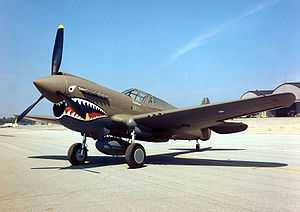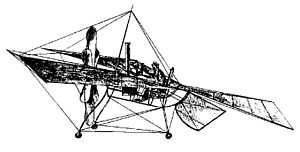Monoplane
| Monoplane | |
|---|---|
 The low wing of a Curtiss P-40 |





A monoplane is a fixed-wing aircraft with one main set of wing surfaces, in contrast to a biplane or triplane. Since the late 1930s it has been the most common form for a fixed-wing aircraft.
Types
The main distinction between types of monoplane is how high up the wings are in relation to the fuselage:
- low wing, the wing lower surface is level with or below the bottom of the fuselage.
- mid wing, the wing is mounted mid-way up the fuselage.
- shoulder wing, the wing is mounted above the fuselage middle.
- high wing, the wing upper surface is level with or above the top of the fuselage.
- parasol-wing, the wing is located above the fuselage and is not directly connected to it, structural support being typically provided by a system of struts and often, especially in the case of older aircraft, wire bracing.
A further distinction is whether the wing is braced with external struts and/or wires, or whether it is a self-supporting cantilever design.
History
Some of the first attempts of heavier-than-air flying machines were monoplanes; the Monoplane built in 1874 by Felix du Temple de la Croix is one example. Other early attempted flights by monoplanes were carried out in 1884 by Alexander Mozhaysky[1] and Clement Ader in 1890.[2]
The first successful aircraft were biplanes, but many pioneering aircraft were monoplanes, for instance the Blériot XI that flew across the English Channel in 1909. Throughout 1909-1910 Hubert Latham set multiple altitude records in his Antoinette IV monoplane, eventually reaching 1,384 m (4,541 ft).[3] The first all-metal aircraft was a monoplane, the German Junkers J 1 which first flew in December 1915.
The equivalent German language term is Eindecker, which appears in the name of a number of German aircraft types, such as the Fokker Eindecker fighters (a successful World War I fighter aircraft produced in 1915). The German military Idflieg designation system prior to 1918 therefore prefixed monoplane type designations with an E, until the approval of the Fokker D.VIII fighter from its former "E.V" designation.
Nonetheless, relatively few monoplane types were built between 1914 and the late 1920s, compared with the number of biplanes. The reasons for this were primarily structural. In the days when wings (whether biplane or monoplane) were thin structures, externally braced by struts, steel wire or cables, the biplane wing formed a strong and fairly rigid lattice truss structure in which the two wing surfaces were braced against each other. Early thin monoplane wings, on the other hand, tended to be liable to twist under aerodynamic loads, rendering proper lateral control very difficult, or breaking.
As all-metal construction and the cantilever wing (both having been pioneered by Hugo Junkers in 1915) became common during the post-WWI period, the day of the biplane passed, and by the 1930s the monoplane was fast becoming the usual configuration for a fixed-wing aircraft. Most military aircraft of WW2 were monoplanes, as have been virtually all aircraft since, as biplanes became relegated during the war to specialized applications such as initial flight training as with the Tiger Moth and Stearman biplanes, and after World War II, to competition aerobatics designs like the Pitts Special.
Advanced monoplane fighter-aircraft designs were mass-produced for military services around the world in both the Soviet Union and the United States in the early-mid 1930s, with the Polikarpov I-16 and the Boeing P-26 Peashooter respectively.
See also
References
- ↑ Gray, Carroll. "Aleksandr Fyodorovich Mozhaiski". Retrieved 8 November 2011.
- ↑ Encyclopedia Britannica : Clement Ader
- ↑ King, Windkiller, p. 227.
| ||||||||||||||||||||||